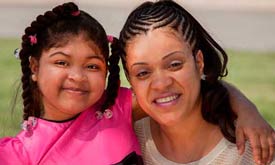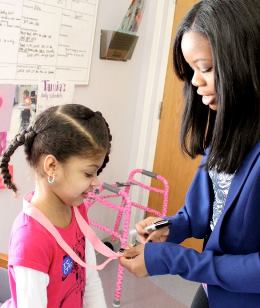Months of pain, mystery and fear ended on a single winter’s day when pediatric specialists at CHKD accomplished in one visit what doctors elsewhere had not been able to do in six months: diagnose Tamia’s illness.
 It all began in the summer of 2012 when 6-year-old Tamia Johnston complained that her legs hurt. Her mother Sheila reassured her that she’d feel better soon.
It all began in the summer of 2012 when 6-year-old Tamia Johnston complained that her legs hurt. Her mother Sheila reassured her that she’d feel better soon.
Watching Tamia sit on the sidelines at her cousin’s birthday party, too weak to sing and dance, was the tipping point for Sheila. She knew something was wrong.
Despite a battery of tests, none of the doctors they consulted in the New Jersey town where they lived could provide any answers. Tamia’s health continued to decline. By September, no longer able to sit up without help or make a fist, she was hospitalized.
Tamia received rehabilitation to treat her symptoms and strengthen her muscles, but the cause of her condition remained elusive, and her progress was soon lost. By November, she could barely muster a smile.
 But weeks later, Tamia could only walk on her toes and struggled to climb a flight of stairs. Worst of all, the usually bubbly first-grader was losing the strength and energy to do her favorite thing … dance.
But weeks later, Tamia could only walk on her toes and struggled to climb a flight of stairs. Worst of all, the usually bubbly first-grader was losing the strength and energy to do her favorite thing … dance.
“I watched my little girl slowly deteriorate. Little by little, she had lost the strength to do everything she loved to do – dance, sing, ride a bike. And when she lost her smile … that’s when I almost lost hope,” Sheila said.
Frustrated and desperate, Sheila packed up her family and moved to Hampton Roads to be near her sister – hoping for a fresh start, another opinion, and most of all, some help for Tamia.
At Douglas Park Elementary School in Portsmouth, a very frail Tamia was assessed by the school system’s physical therapist. Alarmed by Tamia’s weakness, she immediately contacted Janet Martin at Care Connection for Children, a state agency housed at CHKD that helps families of children with long term medical issues coordinate care. Janet began assembling resources available to help Tamia, including an evaluation with a CHKD orthopedic surgeon.
Tamia would never make it to that appointment.
A week after Christmas, Janet received a panicked call from Sheila. “She told me Tamia was very congested and wasn’t breathing right. She was thinner and more frail than ever,” Janet explains. “I told her to trust her instincts and take her to the emergency room at CHKD.”
Sheila got Tamia into the car and headed to CHKD’s emergency room – a decision that would ultimately save Tamia’s life. “Coming to CHKD was the beginning of my miracle,” she recalls.
Dr. Svinder Toor, a pediatric neurologist at CHKD, was called by the ER physician to examine Tamia. After reviewing her medical history and noting her symptoms, he had a strong suspicion of the cause.
“In my experience, progressive muscle weakness plus irritability are good indicators of an autoimmune disorder called dermatomyositis,” Dr. Toor said. “In Tamia’s case, I was very concerned. I have never seen a patient so advanced in the disease. She needed immediate and aggressive treatment.”
Dr. Toor’s first call was to Dr. Christos Gabriel, a pediatric rheumatologist at CHKD, who would be able to confirm the diagnosis and begin treatment. During his examination, Dr. Gabriel identified a purplish rash on Tamia’s eyelids and on the knuckles of her hands. He ordered an MRI that confirmed that Tamia did indeed have an advanced case of dermatomyositis.
“It’s a rare condition, but we’ve seen a number of cases here at CHKD. The rash on her eyelids and knuckles are telltale signs of this disorder,” Dr. Gabriel explains. In Tamia’s case, the disease had reached a critical point. “Her condition was very grave.”
Dermatomyositis is an autoimmune disease that causes inflammation of the skin and muscles. In severe cases, it can affect the heart, esophagus and respiratory system. Tamia’s disease had progressed so far that she lacked the strength to breathe properly, to swallow food – even to smile. Her body’s oxygen levels were critically low, and she weighed barely 25 pounds. Immediately admitted to CHKD’s pediatric intensive care unit, Tamia was put on a ventilator and intravenous feeding to deliver the oxygen and nutrients she desperately needed. Dr. Gabriel began treating the disease with steroids and other medications that would suppress her overactive immune system and reduce inflammation.
Tamia responded well to treatment. After 17 days in the PICU, she was stable but faced severe muscle damage that would require intensive inpatient therapy. CHKD’s rehabilitation team prepared to help her fight her way back to being the active little girl who loved to sing and dance.
“When Tamia came to us, she had a long way go,” says Dr. Jean Shelton, a pediatric rehabilitation specialist at CHKD. “She could not swallow food and lacked the strength to roll over in bed or sit independently. She could not walk or even push herself in her wheelchair. Her speech was barely more than a whisper due to lack of breath support.”
During the weeks that followed, CHKD’s team of therapists worked intensively with Tamia each day. Speech therapists helped with her breathing and swallowing. Physical therapists worked to strengthen her legs and taught her to walk again. Occupational therapists focused on restoring her upper body strength and the fine motor skills she’d lost. Everyone who came in contact with Tamia, from rehabilitation nurses to Child Life specialists, were trained to turn routine activities like brushing her teeth or eating lunch into a therapeutic experience for her body and mind.
Slowly gaining strength, Tamia took on every challenge with her reclaimed smile, a renewed spunk and her characteristic determination – something her mother feared would never return.
“Coming to CHKD was like a miracle to us. After months of tests and unanswered questions, CHKD knew what was wrong the first day we set foot in this place,” Sheila says. “And every day since has been better than the day before. I’m so happy to have my little girl back,” she says.
At the end of February, after 50 days in the hospital, Tamia was able to go home – walking and singing once more. It took dozens of CHKD experts and hundreds of rehabilitative hours to help Tamia get better, and Dr. Gabriel is extremely pleased with her dramatic recovery. “Tamia’s disease is in remission now. She will continue physical therapy and remain on medication for some time to come, but with ongoing observation, her prognosis is excellent.”
It’s been a year since Tamia first complained about the pain in her legs. She now gets physical therapy at the CHKD Health Center at Harbour View in Suffolk and hopes to be strong enough to attend school full days this fall. In the meantime, Tamia has a new goal: “She wants to ride a bike again,” says Sheila, glancing at her daughter whose smile, now back in full force, stretches from ear to ear.
Drs. Svinder Toor and Christos Gabriel practice with Children's Specialty Group, PLLC, at CHKD. Dr. Jean Shelton practices with EVMS Physical Medicine and Rehabilitation at CHKD.